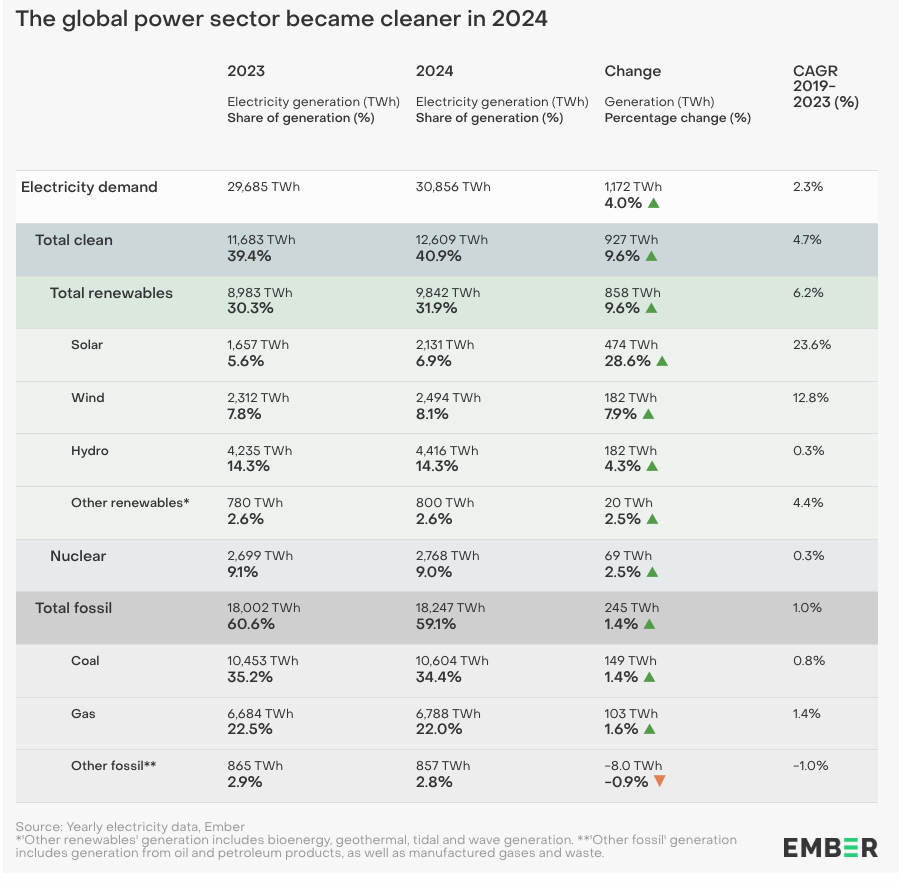
Global electricity production: 41% now carbon-free, but heat waves boost fossil fuel use
In 2024, renewable sources generated a record 9,842 TWh of electricity, driven by a 29% increase in solar power and strong growth in wind energy. Yet surging global demand, fueled by extreme heat, led to increased fossil fuel generation and a drop in nuclear’s share of the energy mix.
Global electricity production: insights from the 2025 Global Electricity Review
Last year, the world consumed more than 30,856 TWh of electricity – a significant increase from 2023. Encouragingly, 40.9% of global electricity production came from zero-carbon sources, according to the 2025 Global Electricity Review by Ember, a leading energy think tank analyzing data from 215 countries.
However, only renewables saw real growth in their share of electricity consumption, while nuclear stagnated.
Key trends in 2024 electricity generation
The report paints a clear picture: low-carbon electricity is steadily gaining ground. Solar and wind, particularly solar, are accelerating the global energy transition. In 2024, solar power set new records in both installed capacity and energy generated, cementing its role as the main growth engine among clean energy sources.
But there was another less encouraging trend: 2024 was the hottest year ever recorded globally. As temperatures soared, so did electricity demand for cooling.
According to Ember, electricity demand rose 4.0% in 2024 – a larger jump than the 2.6% seen in 2023. To meet this growing demand, global fossil fuel electricity generation increased by 1.4%.
Despite nearly 41% of electricity coming from renewables and nuclear, energy-related CO₂ emissions rose by 1.6%, reaching an all-time high of 14.6 billion tons.
Global electricity demand in 2024
How much electricity did the planet use? Global demand grew by 1,172 TWh in 2024, a 4% increase that brought total consumption to 30,856 TWh. This was the third-largest absolute increase ever, surpassed only by the post-recession rebound in 2010 and the post-lockdown surge in 2021.
Weather played a major role in this exceptional rise. Ember’s analysts estimate that higher temperatures alone accounted for a 0.7% increase in demand, a figure comparable to the impact of growing electricity needs from data centers and electric vehicles.
China led global demand growth, followed by the United States and India.
Global electricity production in 2024
On the supply side, solar and wind were again the fastest-growing electricity sources. Together, they accounted for 15% of global electricity generation in 2024 – 6.9% from solar and 8.1% from wind.
Combined, these two renewables have long surpassed nuclear in electricity output, even though nuclear production levels have remained relatively stable. What’s shrinking is nuclear’s share of the overall mix.
In total, renewable energy sources generated 9,842 TWh of electricity in 2024. Solar accounted for 2,131 TWh, and wind added 2,494 TWh. Nuclear contributed 2,768 TWh. Fossil fuels, however, still dominated with 18,247 TWh – mostly from coal (10,604 TWh), followed by gas (6,788 TWh) and other fossil fuels (857 TWh).

Europe’s electricity trends
In the European Union, solar was the fastest-growing electricity source in 2024, up 21% (about 53 TWh) from 2023. Wind grew by just 8 TWh, well below the 30 TWh average yearly increase from 2019 to 2023.
Hydropower and nuclear saw respective increases of 32 TWh (+9.6%) and 29 TWh (+4.6%), driven by favorable weather and the return to service of several French nuclear plants.
Meanwhile, gas-fired electricity generation dropped by 50 TWh (-16%) – the largest decline in any energy segment worldwide. Overall electricity demand in the EU rose by 30 TWh (+1.1%), signaling a return to stability after the sharp decreases seen in 2022 and 2023.
Read here Global Electricity Review by Ember.